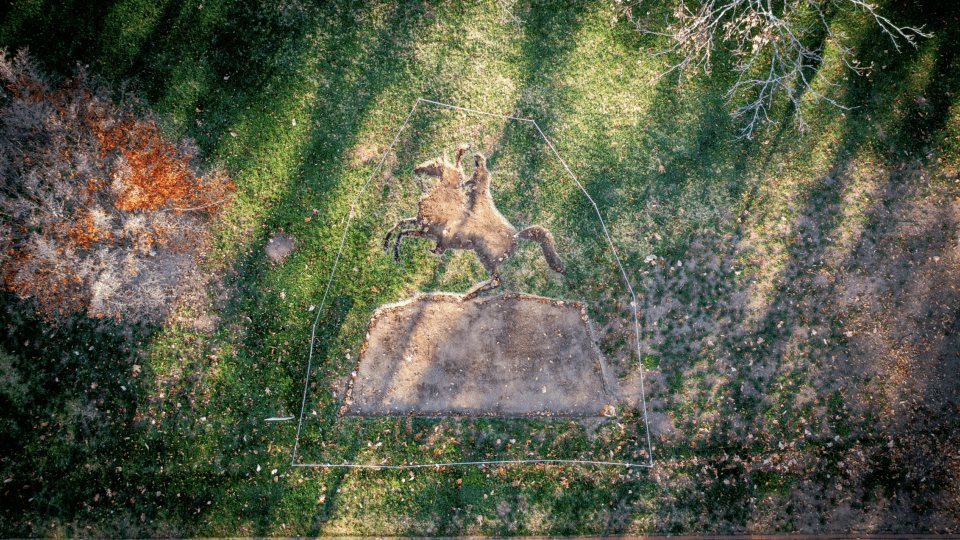‘Unshadowed Land’ Installation Celebrates Resilience of Indigenous Peoples
February 4, 2022
- Author
- Mary Elizabeth DeAngelis

Corn fed the Indigenous people who lived on and farmed the land that’s now Davidson College.
It plays prominently in an evolving art exhibit that acknowledges the Native Americans oppressed by land theft, violence and forced assimilation. And it will symbolize the college community’s efforts to forge an ongoing relationship with Native communities in the region.
Nicholas Galanin, a Tlingit and Unangax̂ artist from Alaska, is behind the year-long, outdoor installation, Unshadowed Land, which started with a dig in the fall. It follows his recent Dreaming in English exhibit at the Van Every/Smith Galleries.
Galanin’s work aims to expose how colonialism resulted in the misappropriation of and profiting from Indigenous art and culture. He works in a variety of mediums, including sculpture, photography, video, textiles and music.
His Dreaming in English exhibit ranges from photographs of empty display cases from the Museum of Natural History in New York (representing stolen artwork); to a room filled with cots like the ones Indigenous children slept in at boarding schools they were forced to attend as part of a government effort to “kill the Indian” in them.
The Unshadowed Land exhibit began in November as Davidson volunteers tilled soil in the shape and scale of the Andrew Jackson monument on Lafayette Square in Washington, D.C. It resides outside the Katherine and Tom Belk Visual Arts Center. This month, volunteers will return to prepare the soil for a spring planting, says gallery director and curator Lia Newman.
Nicholas Galanin’s ‘Unshadowed Land’ Begins to Take Shape
They’ll join members of the Catawba Nation and their Food Sovereignty working group in April to plant the corn inside the Jackson shadow. It’s a relatively small amount, but they’ll plant a much larger crop on the college farm. In summer and fall, the group will harvest the corn to share a meal with Catawba Nation members and give them seeds to help build their collection.
Unshadowed Land is a protest to monuments that honor those who enslaved, oppressed and profited from forced labor and land theft, and a celebration of the Indigenous people who once occupied the land.
It’s a reference to that resilience, to surviving in these spaces despite (colonialization), and issues that we still struggle with today,” Galanin told a Davidson audience in the fall. “Whether it’s subsistence rights, clean water, access to land—it varies across the states, with some communities even fighting for federal recognition.
A Natural Progression
Enslaved people labored at Davidson in the college’s early days. Before that, Native Americans were forced off the Davidson land and many other places—often violently—as white settlers came on to the scene.
Davidson apologized for benefitting from the work of enslaved people and has enacted a series of measures to combat racism and forge relationships with their descendants. Rose Stremlau, associate professor of history, says working with the Native nations impacted by the settlement of the region by college founders is a natural outgrowth of those efforts.
“We want to acknowledge their ancestral ownership of this land and our commitment to tend to it,” Stremlau said. “By planting, harvesting, and gifting, we’re trying to start a process for the college to develop a respectful and reciprocal relationship with the Catawba Nation.”
“Early settlers were all involved in pushing Natives off the land,” Stremlau said. “The sons and grandsons of the men who fought for and benefited from their removal were students here.”
Why Jackson?
The idea behind Galanin’s outdoor art installation is to metaphorically “bury” the Jackson monument.
As a military commander, Jackson, who grew up near the North and South Carolina border, led some of the country’s most aggressive assaults on Indigenous people. As president, he championed the passage of the Indian Removal Act in 1830, which resulted in the forcible removal of more than 60,000 Indigenous people from 25 million acres of land.
“We need to put to rest the narrative behind the Confederacy and the removal of natives,” said Claire Begalla ’24, who helped dig for the exhibit. “These monuments should not be art anymore.”
It’s a college-wide effort. Students in history, biology and environmental studies will assist in research that will go into the college’s archives and be shared with the Catawba Nation. Art students, the college’s sustainability office and physical plant, including The Farm, are also helping.
“We are on Catawba land, our students, faculty and staff understand that we have a responsibility to them,” Stremlau said. “We need to listen, to seek out Native artists, scholars and activists and incorporate events on campus with them.”
That includes DeLesslin “Roo” George-Warren, a Catawba Nation artist and researcher who works to restore food sovereignty and revitalize the native language in his community.
He’s working closely with the college community on the project. The strain of corn they’ll plant is similar to what the Catawba Nation grew many years ago and had lost. It has more nutritional value and needs less water and fewer natural resources, making it far more sustainable than crops from modern mega farms, he said.
“What I’m excited about is that we’re able to bring the corn back up to the land that Davidson is on,” he said, “and that Davidson will be able to help us increase the amount of seed we have for the corn.”
George-Warren says that reclaiming the prized corn is a step toward carving a better outcome for his community.
“A lot has been taken from us,” he said. “While we mourn that loss, we also have a responsibility to the future generations. We have to take these pieces of culture that our ancestors were able to preserve and reweave them into something for the next generations.”
Watch On
Davidson College Van Every/Smith Galleries, In Conversation with Nicholas Galanin: Nicholas Galanin discusses his current exhibition, "Dreaming in English" and outdoor sculpture project, "Unshadowed Land" with Prof. Rose Stremlau, DeLesslin "Roo" George-Warren, and Lia Newman.



